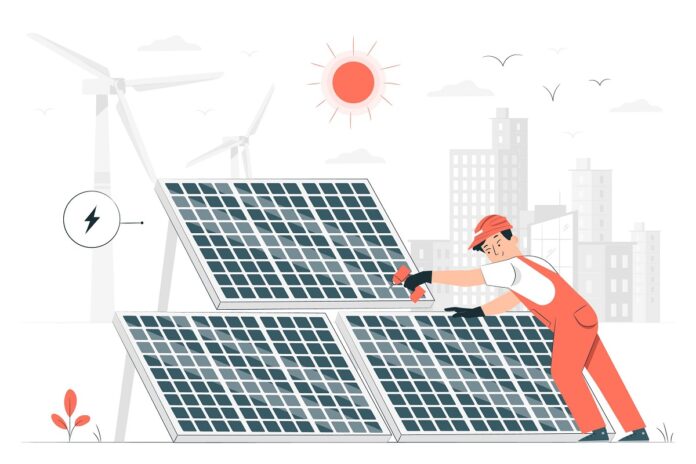Solar energy is a type of renewable energy derived from the sun’s radiation. It is a clean and abundant source of power that can be harnessed and converted into electricity or heat for various practical applications.

How does it work?
Solar energy works by harnessing the sun’s radiation through photovoltaic (PV) cells. When sunlight strikes these cells, it excites electrons within them, generating a flow of direct current (DC) electricity. An inverter then converts this DC electricity into alternating current (AC), which powers homes and businesses. Excess electricity can be stored in batteries or fed back into the grid for credit.


Most common uses of Solar Energy
1. Solar Cooking: A personal way to use solar energy
Solar cookers and ovens use sunlight to cook food, reducing the need for traditional fuels like wood or gas. Solar cooking harnesses solar energy to heat and cook food. Solar cookers, equipped with reflective surfaces, concentrate sunlight onto a cooking pot or container. These devices come in various designs, including box cookers, parabolic cookers, and panel cookers. Dark-colored cooking pots maximize heat absorption. While solar cooking may take longer than conventional methods, it is eco-friendly and eliminates the need for wood, charcoal, or gas as cooking fuels, reducing deforestation and indoor air pollution. It also minimizes greenhouse gas emissions. Solar cookers can bake, roast, steam, and simmer a wide range of dishes. Solar cooking is particularly beneficial in regions with ample sunlight and limited access to traditional fuels, promoting sustainability and lower energy costs. It is also used in disaster relief efforts and for outdoor activities like camping, offering an eco-conscious and practical cooking solution.


2. Solar Lighting: A frequent Examples of Solar powerSolar Lighting: A frequent Examples of Solar power
Solar-powered streetlights, garden lights, and outdoor lighting fixtures are widely used for energy-efficient illumination. Solar energy is extensively used in solar lighting systems to provide sustainable illumination for various purposes. These systems harness sunlight during the day through photovoltaic panels, converting it into electricity and storing it in batteries for nighttime use. Solar lighting applications include:
These lights brighten streets, pathways, and public spaces, utilizing stored solar energy to power LED or CFL bulbs, thus reducing energy costs and carbon emissions.
Decorative and functional, these lights enhance gardens and landscapes with solar panels and rechargeable batteries for hassle-free installation.
Motion-activated lights use solar energy to increase safety around homes and businesses, automatically illuminating when motion is detected.


3. Sunny Solutions: Solar Energy’s Impact on Transportation
Solar panels installed on train roofs or alongside railway tracks can generate electricity to supplement the power needs of electric trains, making rail transport more energy-efficient. Solar panels are integrated into the structure of boats and ships, allowing them to harness sunlight for propulsion and onboard systems. Solar boats are used for transportation, research, and recreational purposes. Solar panels are incorporated into the design of some bicycles and scooters to provide auxiliary power, extend battery life, and enhance the range of electric-assist bikes and scooters.
4. Solar panel for roof: Smart choice for Homeowners
Solar energy can be used for space heating in homes and buildings through passive solar design and active solar heating systems. Additionally, solar cooling technologies like absorption chillers can provide air conditioning. Solar panels on rooftops capture sunlight and convert it into electricity, providing homeowners with a clean and renewable source of energy. This reduces reliance on fossil fuels and lowers greenhouse gas emissions, contributing to a greener environment. Solar panels provide homeowners with greater energy independence. They generate electricity on-site, reducing dependence on external power sources and protecting against power outages.


5. Desalination
Solar desalination plants use solar thermal energy to desalinate seawater, making it suitable for drinking and irrigation in arid regions. Agriculture: Solar pumps and irrigation systems help farmers water their crops efficiently, improving agricultural productivity.
6. Space Exploration
Solar panels are used on spacecraft and satellites to provide electrical power in outer space.
Advantages of Solar energy
Solar energy offers numerous advantages, making it a compelling and sustainable source of power. Here are some key advantages of solar energy:
Renewable and Abundant: Solar energy is an infinitely renewable resource, as the sun provides an enormous and virtually inexhaustible supply of energy. It is consistently available as long as the sun shines, which is estimated to be for billions of years.
Environmentally Friendly: Solar energy production produces no greenhouse gas emissions, air pollutants, or water usage, making it one of the cleanest and most environmentally friendly energy sources. It contributes to reducing air pollution and combating climate change.
Reduced Energy Bills: Installing solar panels on homes or businesses can significantly reduce or eliminate electricity bills, as solar systems generate free electricity from sunlight. Excess energy can often be sold back to the grid for credits or compensation.
Energy Independence: Solar power provides a degree of energy independence, reducing reliance on fossil fuels and foreign energy sources. This is especially valuable in regions with inconsistent or expensive access to grid electricity.
Low Operating Costs: Solar systems have minimal operating and maintenance costs after the initial installation. Regular cleaning and occasional inspections are usually all that’s needed to keep them running efficiently.
Scalability: Solar installations can be designed to meet specific energy needs, from small residential systems to large-scale solar farms. They are easily expandable, making it possible to adapt to changing energy demands.
Grid Stability: Distributed solar installations can enhance grid stability and resilience by reducing strain during peak demand periods and contributing to a more balanced energy supply.
Job Creation: The solar industry creates jobs in manufacturing, installation, maintenance, and research, contributing to economic growth and employment opportunities.
Technological Advancements: Ongoing research and development in solar technology continue to improve efficiency, affordability, and energy storage solutions, making solar energy increasingly accessible.
Remote Power Generation: Solar energy can be harnessed in remote and off-grid locations where extending traditional power infrastructure is impractical or expensive. It’s crucial for providing electricity to remote communities and for disaster relief efforts.
Support for Sustainable Practices: Choosing solar energy demonstrates a commitment to sustainability and environmental responsibility, aligning with global efforts to reduce carbon footprints and transition to clean energy sources.
Solar energy’s versatility, sustainability, and cost-effectiveness make it an increasingly attractive choice for individuals, businesses, and governments looking to reduce energy costs, combat climate change, and promote a cleaner, more sustainable energy future.
Limitations of Solar Energy:
While solar energy is a sustainable and environmentally friendly source of power, it also has several limitations and challenges:
Intermittent Energy Source: Solar energy is dependent on sunlight, which varies with time of day, weather conditions, and geographical location. This intermittency means that solar power generation fluctuates and is not available at night or during cloudy weather.
Energy Storage Costs: To overcome intermittency, solar systems often require energy storage solutions like batteries. However, the cost of high-capacity battery storage systems can be prohibitive for some homeowners and businesses.
Space Requirements: Solar panels require significant space for installation, which can be a limitation for urban areas with limited rooftop or land space. Solar farms may require vast tracts of land.
High Initial Costs: The upfront costs of purchasing and installing solar panels can be substantial, although they have been decreasing over time. Despite long-term savings, these initial costs can be a barrier to adoption for some individuals and businesses.
Energy Conversion Efficiency: Solar panels have limited energy conversion efficiency, typically ranging from 15% to 20% for commercial panels. This means that a significant portion of sunlight is not converted into electricity.
Environmental Impact: The manufacturing and disposal of solar panels can have environmental impacts, including the use of rare materials, energy-intensive production processes, and potential waste management challenges.
Geographical Limitations: Solar energy potential varies by location. Areas with less sunlight or extreme weather conditions may not be as suitable for solar power generation.
Aesthetic Concerns: Some individuals may find solar panels unattractive or objectionable when installed on rooftops, affecting property values or community aesthetics.
Energy Transmission and Distribution: Integrating solar energy into existing energy grids may require upgrades to the transmission and distribution infrastructure, which can be costly and complex.
Environmental Hazards: Manufacturing and disposal of solar panels can involve the use of hazardous materials, and improper disposal can pose environmental risks.
Limited Nighttime Use: Without energy storage, solar power cannot be used during the night, necessitating alternative energy sources or grid connections.
Installation Challenges: Roof condition, shading, and orientation can affect the efficiency of solar panel installations, requiring careful planning and sometimes additional costs.
Despite these limitations, ongoing research and development are addressing many of these challenges, with improvements in energy storage, solar panel efficiency, and cost reduction. As technology advances and more innovative solutions emerge, solar energy’s limitations are expected to become less significant, making it an even more viable and widespread energy source in the future.


